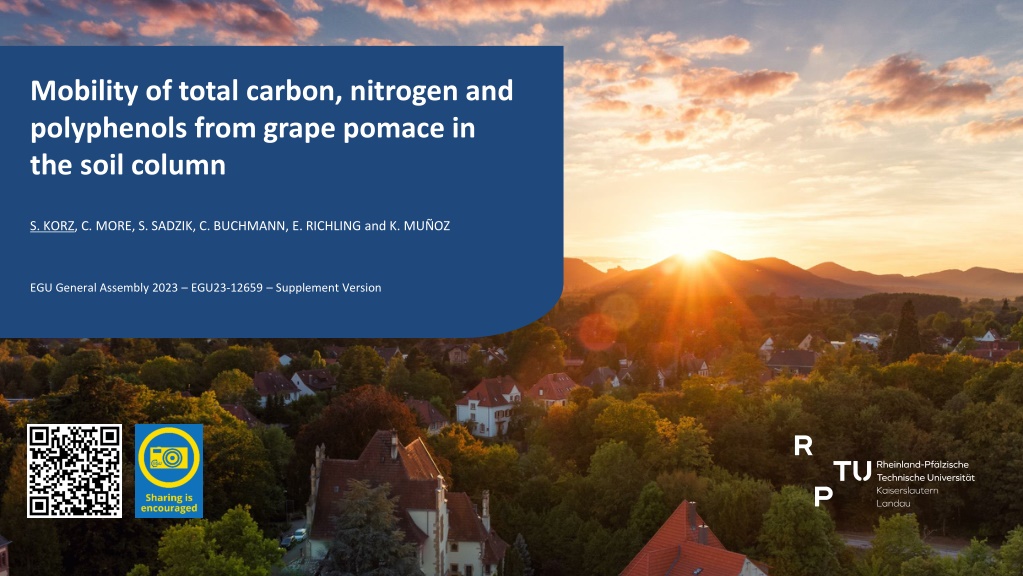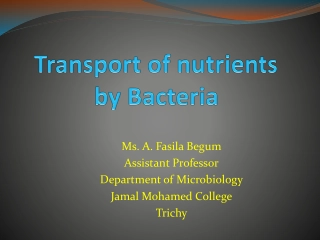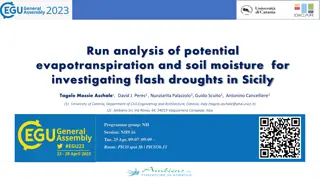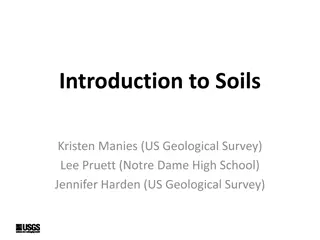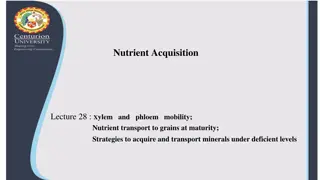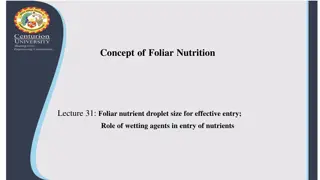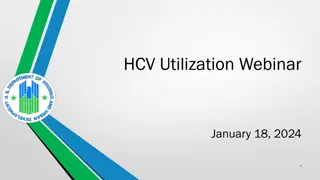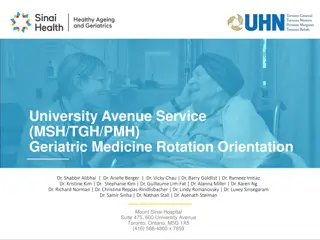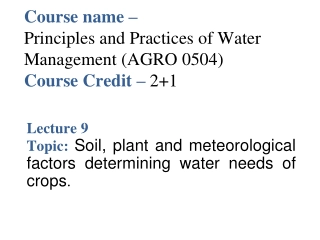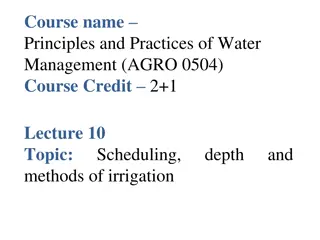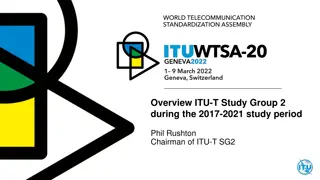Grape Pomace Utilization in Soil Nutrient Management Study
Study on the mobility of total carbon, nitrogen, and polyphenols from grape pomace in soil columns, focusing on its relevance as an organic fertilizer rich in nutrients. The research also highlights the industrial potential of grape pomace, nutrient mobility between varieties, and methods used for characterization and analysis. Sampling details from Neustadt, Germany, and findings regarding nutrient content and water extractability are presented. The study aims to enhance understanding of grape pomace utilization in agriculture for sustainable soil nutrient management.
Download Presentation
Please find below an Image/Link to download the presentation.
The content on the website is provided AS IS for your information and personal use only. It may not be sold, licensed, or shared on other websites without obtaining consent from the author. Download presentation by click this link. If you encounter any issues during the download, it is possible that the publisher has removed the file from their server.
Presentation Transcript
Mobility of total carbon, nitrogen and polyphenols from grape pomace in the soil column S. KORZ, C. MORE, S. SADZIK, C. BUCHMANN, E. RICHLING and K. MU OZ EGU General Assembly 2023 EGU23-12659 Supplement Version
Relevance Use of grape pomace (GP) as an organic fertilizer Rich in nutrients (N,P,K) Cheap and readily available Closing nutrient cycles but Wide C/N ratio Rich in phenolics Low pH Seasonality depended EGU General Assembly 2023 Korz et al. 2
Relevance Use of grape pomace (GP) as an organic fertilizer Focus on industrial use of GP Maximization of extraction efficacy Environmentally relevant processes neglected Nutrient mobility between varieties in different soil types is almost unknown EGU General Assembly 2023 Korz et al. 3
Pomace and soil sampling Proportion of total area in use for agriculture Sampling in Neustadt (Weinstra e, Rhineland-Palatinate, Germany) 3 % 80 % Grape pomace from 4 Vitis varieties: Dornfelder (DF), Pinot Noir (PN), Riesling (RS) and Pinot Blanc (PB) during the harvesting season of 2021 (fresh, directly after pressing) A representative soil sample from the Vineyard + reference soils (sand and silt loam) Fig. 1: Sampling site (Map data: Destatis, Federal Statistical Office, 2023) EGU General Assembly 2023 Korz et al. 4
Methods (Based on OECD) E1) GP and soil characterization E2) Rainwater extraction E3) Soil column and leachate Freeze drying and pulverization Ex. in 1:5 sterilized artificial rainwater (0.01 M CaCl2+ 0.05 % NaN3) Fresh GP application at max. allowed dose Elementary analysis (C and N) Rainwater analysis (TOC and TN) Simulation of a heavy rainfall event Polyphenols via SPE and Folin-Ciocalteu photometrical assay Polyphenols directly via FCR Soil elementary analysis (C and N) TPC via aqueous soil extraction EGU General Assembly 2023 Korz et al. 5
Pomace characterization Despite lower total C content, the water extractableamount is higher in white GP Despite drastically lower total N, the water extractable amount is equal in red and white GP TPC in red GP is ~twice as high as in white GP Fig. 2: Nutrient content in GP and rainwater extraction. Error bars indicate the standard deviation of four replicates. DF=Dornfelder, RS=Riesling, PN=Pinot noir, PB=Pinot blanc EGU General Assembly 2023 Korz et al. 6
Soil characterization Table 1: Parameter of used soils R01A R02A Vineyard NW Texture Sandy loam Silt loam Sandy clay loam 1.5 0.4 Total C (%) 0.95 1.06 0.12 0.01 Total N (g kg-1) 0.08 0.11 46.8 1.3 WHC (g % d.w.) 29.3 47.1 7.3 0.1 pH (CaCl2) 5.6 6.5 Basal respiration ( g CO2-C g-1soil h-1) 0.05 0.01 0.10 0.06 < LOD Glucose respiration ( g CO2-C g-1soil h-1) 0.02 0.02 0.26 0.06 1.0 0.12 449 20 Cmic (mg kg-1) 174 794 EGU General Assembly 2023 Korz et al. 7
Leaching parameters Column dimensions Glass, 300 mm x 50 mm (Length x inner diameter) Soil filling Dry filling of fixed volume, saturation to 100 % WHC GP Application rate 30 t ha-1 or 1:100 (GP:Soil) Rainfall event simulation 200 mm over 48 h or 400 mL of artificial rainwater Soil sample preparation Freezing fractionating by depth homogenization freeze drying Fig. 3: Soil columns EGU General Assembly 2023 Korz et al. 8
Total Carbon and Nitrogen Fig. 4: Total C (4a) and N (4b) content in soils and leachate compared to non-treated soil. Error bars indicate the standard deviation of three column replicates. Statistical differences are analyzed by a Dunnett test comparing the values to the untreated reference group via a t-test. C=Control, DF=Dornfelder, RS=Riesling, PN=Pinot noir, PB=Pinot blanc Significant differences are indicated as: ns: p > 0.05, *: p <= 0.05, **: p <= 0.01, ***: p <= 0.001, ****: p <= 0.0001 EGU General Assembly 2023 Korz et al. 9
Soil and leachate pH DF increasedthe pH in the vineyard soil In two cases leachate pH was decreased Leachate pH higher than soil pH Fig. 4: Soil and leachate pH compared to non-treated soil. Error bars indicate the standard deviation of three column replicates. Statistical differences are analyzed by a Dunnett test comparing the values to the untreated reference group via a t-test. C=Control, DF=Dornfelder, RS=Riesling, PN=Pinot noir, PB=Pinot blanc Significant differences are indicated as: ns: p > 0.05, *: p <= 0.05, **: p <= 0.01, ***: p <= 0.001, ****: p <= 0.0001 EGU General Assembly 2023 Korz et al. 10
Total polyphenolic content Highest recovery in the upper soil layer Lowest recovery in the vineyard soil Highest recovery in the RS treated ref. soils Fig. 5: : TPC in three different soil depths, leachate and total content. Vertical lines indicate the mass balance between leaching and maximum aqueous extractable TPC of fresh GP (rainwater experiment). Points indicate the recovery (%) between total and soil water extractable TPC. Mean values of the total content were set to 100%. Numbers indicate the recovery (%) of soil water-extractable content based on maximum aqueous-extractable TPC. Blank treatments were subtracted from GP treatments. EGU General Assembly 2023 Korz et al. 11
Soil content after pomace treatment C N TPC pH Soil No effect (Exception: Increased in Sand-PB) No effect increased Silt < Sand, Lower < Upper, No effect of GP variety No effect (Exception: Increased in Vineyard-DF) Leachate increased RS<PB<PN<DF, No effect of soil type decreased Red < White, No effect of soil type increased DF<PN<PB<RS, No effect of soil type increased No effect of GP and soil type (Exception: Decreased in Vineyard-PB and 02A-RS) EGU General Assembly 2023 Korz et al. 12
Take home messages C and N are more mobile from white GP water solubility C is hardly retained, especially by sandy soils C leaching N input from GP is mainly due to mineralization and not due to initial leaching Seasonality needs to be taken into consideration In silty soils, polyphenols from GP are most relevant in the upper 10 cm highest microbial activity need for incubation studies Strong dependency on soil parameters chemical stability (soil pH) and sorption processes Soil buffer capacity stable against acid GP medium EGU General Assembly 2023 Korz et al. 13
Acknowledgements Contact: Institute for Environmental Sciences Working Group of Soil Chemistry https://nuw.rptu.de/ags/uchemie Department of Chemistry Division of Food Chemistry and Toxicology https://chem.rptu.de/ags/ag-richling The project is being funded by Carl-Zeiss-Foundation, project number P2021-00-004 EGU General Assembly 2023 Korz et al. 14
